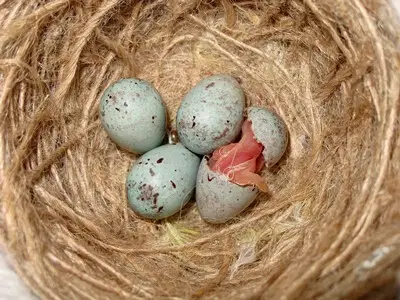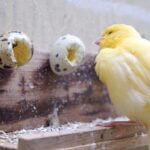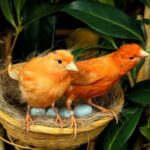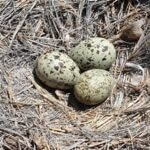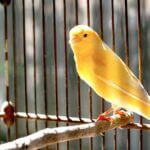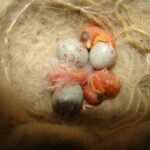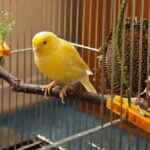Once the hen has laid a clutch of eggs, you’ll need to check if the eggs have been fertilized.
For new breeders, differentiating between fertilized and unfertilized eggs can be challenging. However, there are several ways to check if an egg is viable.
Whether you use the candle method or check for air cells and cracks, you can determine if an egg is fertilized without the assistance of a vet.
What Do Fertile Canary Eggs Look Like?
Since eggs have developing embryos, fertile eggs should appear darker than unfertile eggs, which are almost transparent.
To the naked eye, both eggs will have the same blue color, which is synonymous with canary eggs.
According to the Journal of Ornithology, fertilized eggs in passerine birds, particularly those with embryos, are usually thinner on their equator (the widest part) than eggs with no embryos.
This refutes the popular belief that fertile eggs are thicker due to having life growing inside them.
So, if you’re a keen observer, you can differentiate them even without using the candle method. Just compare the canary’s eggs and identify those that look noticeably thinner and smaller.
How To Tell If Canary Eggs Are Fertile
The easiest and most common method is to “candle” the egg.
This involves shining a bright light through the egg, giving you a better view of what’s inside of it.
The egg membranes of smaller birds are considerably lighter. So, light can easily penetrate the egg and give you a view of the interior.
Below is a simple step-by-step candling guide:
Wash Your Hands
Since they become more porous, canary eggs are susceptible to bacterial infections, especially when close to hatching. To prevent bacteria from getting into the eggs, wash your hands before touching them.
Place a Towel on A Table
Put a towel or pile of clothes on a table. Then, take the eggs you want to candle and rest them on top. When candling an egg, ensure it’s above the towel or clothing pile.
The soft surface protects the eggs from breaking if they slide from your grip. Also, eggs placed on a ruffled towel are less likely to roll and drop on the floor.
Remove Distractions
When candling multiple eggs, do so in a quiet room. Keep any small kids and pets away from the room, as they can disturb the eggs or cause you to lose your grip.
Switch Off Lights
Candle the eggs in a dark room, as it gives you a clearer image of what the egg looks like inside. Before switching off the lights, arrange the eggs in a reachable place and keep your flashlight in hand.
Candle the Eggs Individually
Take one egg, place it between your thumb and forefinger, and with the other hand, shine the flashlight through the egg, preferably from below.
If you can see any activity inside the egg – be it a couple of veins or a visible embryo – consider the egg to be fertilized.
If you can’t see through the egg or it is devoid of visible veins, consider it unfertilized.
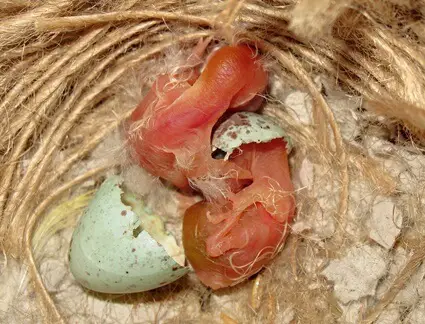
Return Eggs To The Incubator
Only keep the eggs away from the incubator or breeding nest for as long as it takes to candle them. Never let this be more than 30 minutes at a time.
For fertile eggs, keep incubating them. For the eggs that don’t appear fertilized, return them for further incubation and re-do the test after 3-4 days to see if there are any changes.
Additional Checks During Candling
Apart from the spider web of veins that indicate the start of embryo development, check for the following as you candle the eggs:
Air Cell
This is typically the empty space on one end of the egg during candling.
At the start of the incubation process, the space is very small. However, as the embryo grows, it becomes bigger, occupying up to a third of the egg.
The air cell is primarily an indicator of humidity, with an abnormally large cell indicating low humidity and a smaller cell indicating higher humidity. Both extremes are bad for the chicks.
High humidity means the chick can drown in the excess water. Meanwhile, low humidity and the overly large air cells they cause lead to smaller chicks than normal.
Canaries are adept at turning their eggs from side to side, so you won’t have to worry about humidity levels. However, you may need to maintain the temperatures within the cage at 90-95 degrees Fahrenheit to ensure the humidity remains at a constant level.
Cracks
Hairline cracks are common and are mostly caused by contact with sharp objects.
Despite being very small, cracks can allow moisture, dirt, and bacteria to seep inside the egg, which often leads to the death of the embryo or the egg not hatching.
T|hese cracks are visible on close inspection during candling. Any egg with cracks should be removed and replaced with another egg.
Best Time to Check Canary Eggs for Fertility
Wait until the canary has brooded on the eggs for at least 4 days before checking them for fertility. At this point, the development of an embryo will be advanced enough to be visible under light.
Further, before you let the bird sit on the laid eggs, ensure it has finished laying its final egg of that particular breeding season.
Normally, canaries lay 3-5 eggs per clutch, but some birds can lay up to 7 eggs. The egg-laying takes place daily, so 2-3 consecutive days of no eggs should signify that the bird has exhausted her clutch of eggs.
To prevent irregular hatching timelines, remove the eggs from the nest as soon as they’re laid and keep them in a safe, dry place until the canary has finished laying.
Put them back into the breeding nest for the bird to sit on. This way, all chicks will be hatched on the same day, or at most within a two-day window, and will thus grow up at the same rate.
This prevents certain chicks from being too small to compete for food with others, reducing mortality rates.
Canaries count their eggs and will abandon the nest (and the hatching process) if they notice some of their eggs are missing. The fact that birds automatically attribute the lost eggs to the presence of predators further makes things worse psychologically.
So, it’s common practice to carefully steal the eggs from the nest when your canary is involved in other activities, like eating or playing outside.
Then, replace the eggs you take with fake eggs and put the real eggs in safe storage.
What To Do If You Find All Eggs Are Unfertilized
If you find out that all of your canary’s eggs are unfertilized, you can buy fertilized eggs from an avian store and give them to the mother to sit on or take the duds away.
If you choose the latter option, take the mother and her male partner for a medical examination at the vet. If the pair is okay, feed them with the breeding supplements and wait for the female to lay another clutch of eggs, typically in 10-14 days.
Causes of Unfertilized Eggs
If you find most of the canary’s eggs are unfertilized or are concerned about consistently poor hatching rates, the following factors are most likely to blame:
Poor Nutrition
Egg production requires high levels of dietary calcium, which forms the eggshell.
If the mother consumes low-calcium foods, it’ll most likely produce weak and misshapen eggs, most of which won’t hatch or support embryo formation.
Other equally important nutrients to reproductive performance include sodium, vitamin D, and vitamin E. The International Journal of Molecular Science found that vitamin E, commonly found in vegetable oils, positively impacts fertility in canaries.
However, it’s not just a lack of nutrients that causes infertility. Low-quality foods can also lower fertility levels. For instance, feeding your canary with seeds affected by aflatoxins can cause it to be infertile.
Disease
Diseases affect fertility levels in male and female canaries and egg production rates in the former. The diseases that affect canaries include canary pox, air sac mites, feather cysts, and mycoplasma.
Canary’s Behavior
It’s not guaranteed that two canaries will mate when put in the same cage. Because canaries aren’t social birds, it is common for male-female pairs to start fighting, making them less likely to mate.
Physical Injuries in Males
Sometimes, male canaries have injured or blocked cloacas, usually due to trauma.
As a consequence, their sperm can’t reach the female’s oviduct. In such cases, even repeated mating won’t change the outcome, and most eggs will be infertile.
Chemical Exposure
According to Environmental Health Perspectives, canaries may be adversely affected by exposure to pesticides and industrial chemicals.
In male canaries, exposure may reduce sperm quality. Meanwhile, in female canaries, the effects range from inhibited egg production to eggshell thinning to poor egg incubation habits.

